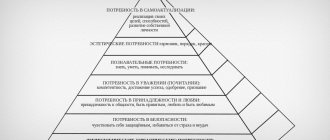What is motive
Motive
- this is a process that controls human behavior, contributing to its organization, direction, activity and stability. It is also believed that a motive is a certain generalized image of material or ideal objects that are valuable to an individual.
Achieving these objects is the meaning of his activity for him. To a person, a motive is presented in the form of special experiences that can be both positive (when expecting to achieve these objects) and negative (when realizing the incompleteness of one’s position, the lack of this object). Schopenhauer was the first to use the concept of “motivation” in psychology.
Nowadays, the word “motivation” in psychology is understood in different ways. Some researchers believe that this is a set of processes responsible for motivation and activity; while others believe that it is a purely mental phenomenon, representing a collection of motives.
What is motivation in psychology in essence? This concept is used where they talk about achieving a certain goal and specific ways to achieve this. It is known that the same goal can be achieved in different ways.
So, if a person wants to become rich, then he can get a job in a prestigious company, open his own business, write a good book, engage in criminal activity... And vice versa - the same action can be performed for different purposes.
In addition, the desire to achieve a specific goal can also be explained by one’s own considerations. Why does a person want to get rich? Someone wants to buy a mansion by the sea, someone wants to get married, someone wants to professionally do what they love (and not something that just generates income). In such cases, they say that a person is guided by certain motives.
Usually, a person organizing some kind of activity and achieving a certain goal is guided by several motives at once, which is why psychologists talk about one or another motivation. The problem of motivation in psychology is one of the most difficult. Often a person himself does not realize exactly what motives he was guided by when he performed some actions.
There are hidden motives associated with some memories, fears, etc. Such motives are not reflected in consciousness and act on a subconscious level; a person only feels some kind of vague tension, discomfort, which he strives to overcome with the help of certain actions.
Thus, a goal is what we want to achieve, and a motive is the reason why we want to achieve it. Motivation in psychology is understood as both the set of motives that control an individual’s behavior and the process of this control itself.
Motive, need, goal
Motive
(from Latin movere - set in motion, push) - 1) motivation for activity related to meeting the needs of the subject; 2) object-oriented activity of a certain strength; 3) the object (material or ideal) that motivates and determines the choice of direction of activity, for the sake of which it is carried out; 4) the conscious reason underlying the choice of actions and actions of the individual. In psychology, a number of features of the nature and functions of the motive in the regulation of the subject’s behavior have been identified: the incentive and directive functions of the motive (psychoanalysis, behaviorism, dynamic psychology, K. Lewin’s “field” theory (see Topological psychology), ethology), the determination of human behavior by unconscious motives ( psychoanalysis), hierarchy of motive (psychoanalysis, “humanistic psychology”, etc.), purposefulness of activity (activity theory), striving for balance and tension as mechanisms of motive dynamics. The development of the motive occurs through a change and expansion of the range of activities that transform objective reality. In animals, the range of objects that act as a motive is given by nature and is limited by a range of adaptive forms of activity specific to each biological species. In humans, the source of motive development is the process of social production of material and spiritual values. Such potential motives in ontogenesis are the objective values, interests and ideals inherent in a given society, which, if internalized by a person, can acquire motivating force and become really effective motives. These motives perform the function of meaning formation, that is, they give personal meaning to the reality reflected in the individual consciousness.
Need
(in psychology) - the state of an individual created by the need he experiences for objects necessary for his existence and development, and which serves as a source of his activity. Need acts as a state of personality through which behavior is regulated and the direction of a person’s thinking, feelings and will is determined. A person’s needs are determined by the process of his upbringing in a broad sense, that is, introduction to the world of human culture. Since the process of satisfying a need acts as a purposeful activity, needs are a source of individual activity. If in need a person’s activity is essentially dependent on its objective-social content, then in motives this dependence is manifested in the form of the subject’s own activity. Therefore, the system of motives revealed in a person’s behavior is richer in characteristics and more mobile than the need that constitutes its essence. Nurturing needs is one of the central tasks of personality formation.
TARGET
- a conscious image of an anticipated, desired result, towards which a person’s action is aimed; a preconceivable result of conscious activity. What is meant here is a conscious image of the result: it is held in consciousness the entire time the action is performed. The goal is always conscious. In psychology, the concept of goal is also used in other meanings: 1) a formal description of the final situations that any self-regulating functioning system strives to achieve; 2) an anticipated useful result that determines the integrity and direction of the organism’s behavior. The idea of a goal as an anticipated useful result is used in the analysis of the biological background of the emergence of a perceived goal and the study of psychophysiological mechanisms for regulating purposeful behavioral acts. The concept of a goal as a conscious image of an anticipated result is used in the study of voluntary intentional actions that represent a specific feature of human activity (=> goal formation). The more complex the goal, the longer the path you need to go to achieve it. Therefore, achieving big goals involves forecasting and planning activities. Planning involves putting forward both final and intermediate goals. The developed system of goals and means provides for a targeted change in objects and the activity itself. The goal sets the action, the action ensures the achievement of the goal. By characterizing the goal, you can characterize the action. Goals can be very diverse, and most importantly, different in scale. Large targets are divided into smaller ones, which can be further fragmented. Accordingly, a major action is a sequence of actions of a lower order with transitions to different levels of the hierarchical system of actions. To understand what motivates a person to set goals and achieve their implementation, you need to turn to the concepts of needs and motives.
Types of motives in psychology
Psychologists identify a large number of types of motives, dividing them into several categories. It is not easy to create such a classification, since there are a lot of circumstances that guide a person; Each direction of psychology and each school has its own system. However, the most widespread division of motives into four groups.
Internal and external motives
These types are important not only in terms of the choice of means and ways to achieve the goal, but also for the self-realization of human individuality. Internal motives are such as interests, hobbies, the need for positive emotions and avoidance of negative ones, the desire to increase self-esteem, etc. These circumstances are related to the person himself and his attitude to his activities.
External motivation is circumstances that do not depend on a person and his desires and lie outside his personal sphere. These may be motives such as public opinion, a change in weather, the desire to get a higher grade or avoid punishment, etc.
External and internal motivations can work simultaneously, or they can act separately. For example, a student diligently does his homework. He can do this both because he is interested in the topic, and in order to get a good grade, please his parents, brag to his friends, etc.
External motivation plays a fairly large role in human life, since most people need a certain socialization. Such motives are often more effective than internal ones; this is the same “kick in the ass” without which some people will not do anything at all. However, for personal development, internal motives are still the most preferable. Only with their help can you do your work truly productively. All creative activity is based primarily on internal motivation.
Positive and negative motives
Like needs, drives are associated with emotions. A person in his actions can be driven by the desire to receive pleasure, pleasure, and then this is a positive motivation, or he can also be driven by the desire to avoid punishment, pain, fear and other negative experiences, and then this is a negative motivation.
Researchers cannot yet definitively say which of these motives are more effective in achieving a goal. Negative motivation can encourage one to overcome obstacles, endure minor inconveniences, and work until exhaustion; but it also destroys a person who will never truly love or understand his business. Therefore, positive motives still seem more preferable.
Sustainable and unstable motives
Stable motivations are those that are based on human needs and do not require any additional reinforcement. Such motives have existed for quite a long time. Unsustainable motivation changes quickly. Thus, the internal motivations of the individual are stable, since changes in worldview, interests, and tastes occur rarely and gradually. External motivation, on the contrary, is unstable, since the demands of society, the mood of others, and the weather outside change quickly.
Achieving success
This is a separate type of motivation that has become relevant recently. Modern society sets a person up for success from childhood. It is not prestigious to be unsuccessful; success brings with it material well-being, public recognition, and other benefits. Success increases a person's social status.
It would seem that every person wants to achieve success. However, in reality, there are many obstacles on the way to achieving it, which sometimes discourage the desire to achieve success altogether. One of the reasons for this is a person’s lack of understanding of why he needs to achieve this goal. It happens that the set goal is too far away and gets lost among the many obstacles that arise; in this case, it is advisable to break the achievement of this success into several intermediate goals.
Often achieving great success involves leaving the so-called comfort zone. This means sacrificing something small in order to get something much bigger in the end; the ability to take risks, endure small troubles with the expectation that these problems will be more than compensated for when success is achieved. And this is where many potentially successful people give up.
Often the “comfort zone” is presented as a physical, mental, ideological or spiritual space in which a person feels good and comfortable, he does not suffer and, it would seem, is provided with everything he needs. In fact, psychologists understand something different by this concept. For some people, the “comfort zone” is associated precisely with suffering, inconvenience, pain, and leaving this zone can relieve suffering and bring happiness. But a person does not want to make this exit; he feels “good” when he feels bad. What is the reason for this paradox?
This situation is perfectly illustrated in the famous play “Dragon” by E. Schwartz, based on which a film was made in the late 80s. The inhabitants of the fairy-tale city come to terms with the fact that a terrible dragon has established dictatorial rule over them, who sets his own rules and, in particular, regularly demands that the most beautiful girls in the city be given to him.
When a brave knight appears and kills the dragon and gives the inhabitants freedom, they immediately... elect a new dictator who makes them suffer in the same way. It turned out that the residents could not make an effort to learn to live without any dictators and suffering: in their minds, freedom, thinking, responsibility and hard work seem to be even greater suffering than the insane rules of this or that dictator, which one can get used to.
The dragon freed people from the need to think and gave them, albeit unfair and deceitful, but a simple and understandable picture of the world, which was enough to learn by heart.
Motives and goals
The term “will” denotes that side of mental life that receives its expression in the conscious, purposeful actions of a person.
Human actions come from certain motives and are aimed at certain goals. Motive is what motivates a person to action; goal is what a person strives to achieve as a result of this action.
When setting one goal or another, a person is always guided by certain motives, certain motives. Goal setting cannot happen without reason. Something must motivate a person to direct his activities towards this goal. Motives are what motivate a person to set certain goals. Without knowing the motives, it is impossible to understand why a person strives for one goal and not another; therefore, it is impossible to understand the true meaning of his actions.
The initial motivation for activity is need , i.e. the need experienced by a person for something. We can distinguish between material needs—the need for food, clothing, housing, etc.—and spiritual or cultural needs—the need for communication with people, the need for education, books, music, etc.
Spiritual needs historically arose in the process of social labor as initial material needs were satisfied and further developed and refined. Labor activity itself was born out of the need to satisfy these pressing material needs. But later it became a source of new needs, the most important of which is the need for work itself, which is based, on the one hand, on the organic need for activity, characteristic of any healthy organism, on the other, the need for communication with people, the basic and original form of which is labor, production communication. This need for work could only receive full development in a socialist society, when labor, having become truly free, turned “from a shameful and heavy burden, as it was considered before, into a matter of honor, into a matter of glory, into a matter of valor and heroism” (Stalin) .
A need causes a desire to satisfy it; the desire can be expressed in attraction or desire.
- Attraction is a vague desire that is not associated with a clear idea of the goal. The originality of attraction is perfectly conveyed in the famous words of Pushkin: “If it weren’t for the vague attraction of a thirsty soul for something...”
- Desire is a conscious desire for a certain object, for a certain goal. The transformation of vague inclinations into conscious desires is a necessary condition for conscious and purposeful activity in which the human will is manifested.
Not every desire, however, leads to action . A person can also wish for something that is not at all in his power, that does not depend in any way on his actions: a person can wish that the weather will be good tomorrow, that the book he needs will be unoccupied in the library, that the performer he is interested in will participate in the play, and etc. In these cases, there is a conscious orientation towards a certain goal, but there is no desire to act to achieve this goal, because there is no awareness that achieving it depends on the person who wants it.
Such desires can be called ineffective desires, in contrast to effective desires, which are associated with the thought not only of a goal, but also of the means to achieve it, with the awareness of the possibility of achieving this goal and with the desire to act in this direction.
Effective desires underlie human volitional activity.
Needs are the prerequisite on the basis of which the motives of human activity are formed. Based on the needs in the process of social life, a person’s feelings and, in particular, his social feelings develop, his interests are created, his views and beliefs are formed, and finally, his worldview is formed. And in the feelings, and in the interests, and in the beliefs, and in the worldview of a person, since they become a source of effective desires, the motives of his activity appear.
The problem of the struggle of motives
As already mentioned, a person is simultaneously controlled by several motives, often prompting him to different actions. For example, a classic situation. It’s early morning, the alarm clock rings, which you set specifically to get up early and go for a morning run. But that was yesterday, and now I really don’t want to get out from under the warm blanket when I can sleep for another half hour.
What will you choose, which motive will win? This depends on many factors, including the importance of motives, willpower, common sense and additional incentives. For example, if you agreed to run with a friend, and he will wait for you.
In the example given, the situation is not so critical, but it happens that a person is faced with a very difficult choice: to save himself or to save other people, to commit a crime and achieve a goal, or not to commit and give up what he wants. The struggle of motives can become a source of very complex and severe internal conflict, leading to the development of neurosis or depression.
Psychologists in a situation of conflict of motives advise relying on the rational sphere, that is, not giving in to emotions, thinking over the arguments for and against, assessing the pros and cons of one or another course of action. And most importantly, focus on the most socially significant motives. After all, having achieved your goal, but lost the trust and respect of society, you will lose more than you gain.
Despite the fact that we are not aware of all motives, it is possible to control the motivational sphere. To do this, you should learn to build a hierarchy of motives, focusing on the most important and significant ones. The hierarchy of motives is associated with social values and the priorities that exist in our lives.
Functions of motives
- Incentive - reflects the energy of the motive, is associated with the emergence of a need state, which causes the mobilization of energy, and is manifested in the fact that the motive determines a person’s activity and behavior;
- Directing – reflects the direction of the motive energy towards a specific object, which determines the choice of behavioral strategies;
- Regulating (controlling) – the motive predetermines the nature of behavior, which depends on which motives turn out to be the most significant at any given moment in time; this function includes organizing, controlling, structuring, and meaning-forming functions;
- Stimulating – is associated with the continuation of motivation and the implementation of intentions: the energy mobilized when a state of need arises does not disappear until the need is satisfied.
What is Motivation? Motivation concept
In domestic and foreign psychology, many definitions of the concept of motivation have been given, several concepts and motivational models have been developed (the theory of A. Maslow, Herzberg, McClelland).
The word Motivation is a specific and unique system of internal and external incentives that encourage a person to express himself in one way or another. To many people, this concept will seem something sublime, but it is motivation that helps in achieving the goal; it shapes the desires and aspirations of the individual.
If a school graduate wants to become a programmer in the future, then he will be motivated to enter the information faculty and will make every possible effort to do so. And, having become a student of the desired faculty, he will experience unprecedented joy, and his studies will turn out well.
Another example: if a person is hungry, he will be motivated to suppress this feeling, his actions will be aimed at preparing food or buying ready-made food. After satisfying this need, the lowest, according to A. Maslow’s pyramid, a person will experience positive feelings and will be active to achieve other goals.
Most scientists put into this concept everything that encourages a person to be active, calling it a motive. Motives are a set of techniques, explanations of a person’s actions and deeds, or an object (not necessarily animate), towards the possession of which the activity of the individual is directed.
Domestic psychologists S.L. Rubinstein and A.N. Leontyev defines motives as a certain human need, both conscious and unconscious.
An example of an unconscious motive: this is constant criticism and reproaches of another person for small mistakes, which is realized by a person as an increase in his importance and activity, but this is typical for people who are unsure of themselves. The motives of the criminal are often hidden not only from law enforcement agencies, but also from the criminal himself.
To realize the motive, it is necessary to do careful inner work.
In science, it is customary to distinguish between the concepts of motive, goal and need:
- need is a conscious or unconscious internal urge;
- goal is the conscious final result of one’s actions;
- the very definition of motive was described above.
In order to determine your own motivation, you need to answer the following questions:
- Why am I doing this?
- What needs do I have that I want to satisfy?
- What results do I expect to get from my actions and the degree of their significance for me?
- What makes me act this way and not otherwise?
Main characteristics of motivation
Motivation has its own characteristics:
- direction,
- hierarchy and stability of goals,
- mediated by the intellect of the individual;
- has a social origin.
Taking into account the above characteristics, school programs, areas of additional education, incentives for enterprise employees, social support for women in the state, and so on are being developed.
Concept and functions
The term motivation comes from the Latin word movere, which translates as “to move.” This concept has several interpretations:
- Inspiration to action.
- Dynamic psychophysiological process. It helps control behavior. Activity, stability, direction, organization are determined.
- The ability of an individual to satisfy desires through activities.
Main functions:
- Stimulating - encourages an individual to perform certain actions. Motivation will be present until the individual gets what he needs.
- Directing - redirects energy to the desired object. Behavioral strategies depend on this function.
- Incentive - causes a state of need, in which the mobilization of energy begins. Behavior changes, increased activity in actions appears.
- Regulatory - the nature of behavior is predetermined by motive.
Many people confuse motive with goal or need, but these concepts have different interpretations. Needs are a subconscious desire to get rid of discomfort. A goal is the result of a person’s conscious choice and direction of action.
Stages of the motivational process
Motivation as a process can consist of several sequential stages:
- The occurrence or shortage of something (need);
- Finding ways to satisfy or eliminate ways of dissatisfying needs;
- Defining goals, specifying them and finding ways to achieve them;
- Direct implementation of the action;
- Awareness of obtaining or not obtaining the desired result;
- Cessation of an action as a result of satisfying a need, or searching for new ways to terminate one’s need.
Classification of motivations
Motivation processes are distinguished according to the following criteria:
By way of use:
- normative – motivating the subject to action with the help of instructions, psychological influence, explanation, suggestion, information;
- coercive – the use of blackmail, threats and intimidation to induce an individual to act.
- stimulating - the creation of external circumstances that encourage a person to be active.
According to the source of motives:
- Internal (another name is intense) - motivation aimed at satisfying a person’s internal desires, is formed under the influence of the aspirations and personality traits of the person himself. For example, the desire to finish a project faster, fear of heights, desire to draw.
- External (extreme) – motivation based on external environmental circumstances. For example, wages for employees, rules of student behavior in class, working conditions.
Based on the results of the action:
- positive - a person’s activity with the aim of receiving positive reinforcement (a salary increase, time off for an employee, watching a cartoon or going to a playroom for a child);
- negative – avoiding the negative consequences of one’s actions (fines, decreased trust of the team).
By duration:
- stable – lasts a long period of action, does not require additional reinforcement;
- unstable - characterized by a change in phases of personality activity, needs additional stimulation.
By coverage:
- personal, concerns one specific person;
- group – motivation aimed at a group of people united by a common characteristic.
Application in various fields
Psychologists have identified different methods of motivation that can be effectively used in work, relationships, etc. The most effective include methods used in psychology, management, and economics.
In psychology
Techniques:
- Self-hypnosis is a process by which a person independently influences his psyche. The main goal is to change behavior, actions, beliefs, interests. With the help of self-hypnosis, a person can make his behavior unusual. For the method to work, you need to prepare a list of attitudes and statements that seem correct. When making statements, you cannot use the particle “not”.
- Affirmations are expressions or small texts that can be used to influence a person on a psychological level. For affirmations to work, you need to divide a blank sheet of paper into two parts. On the left write negative statements that cause fear and anxiety, on the right - positive ones. It is important to write down negative statements in detail to reveal hidden fears. After this, you need to cut the sheet into two parts, carry the side with positive affirmations with you constantly, reading them every day.
- Self-motivation is the desire, the desire to continue activities when natural motivation is lost. You need to constantly look for reasons that will make you continue to act so as not to give up.
In management
Motivation techniques used in management:
- Economic - material incentives. These include increased wages, financial assistance, bonuses, and loans.
- Non-economic - moral, psychological or organizational. These include praise, support, approval, trust, respect, blame, prospects for further growth, delegation of authority, tasks.
In economics
The main methods of motivation in economics:
- penalties;
- social payments;
- rewards.
Scope of application of the concept
The concept of motivation is used both in everyday life - to regulate the behavior of the individual himself and his family members, and from a scientific point of view - in psychology, economics, management, etc.
In psychology
The science of the soul studies the connection of motives with the needs, goals, desires, and interests of a person. The concept of motivation is considered in the following main directions:
- behaviorism,
- psychoanalysis,
- cognitive theory,
- humanistic theory.
The first direction claims that the need arises when the body deviates from a certain ideal norm. For example, this is how hunger arises, and the motive is designed to return a person to his original state - the desire to eat food. The method of action is determined by an object that can satisfy the need (you can cook soup or have a snack with something ready-made). This is called reinforcement. Behavior is formed under the influence of reinforcements.
26.07.2019
3 558
30 best books on psychology that everyone should read
Greetings, friends. Today I have prepared for you a selection of useful...
In psychoanalysis, motives are viewed as a reaction to needs formed by unconscious impulses. That is, in turn, they are based on the instincts of life (in the form of sexual and other physiological needs) and death (everything related to destruction).
Cognitive (cognitive) theories present motivation as a result of a person’s understanding of the world. Depending on what his vision is aimed at (for the future, to achieve balance or to overcome imbalance), behavior develops.
Humanistic theories represent a person as a conscious person capable of choosing a path in life. The main motivating force of his behavior is aimed at realizing his own needs, interests and abilities.
In management
In personnel management, motivation is understood as encouraging people to work for the benefit of the enterprise.
Theories of motivation in relation to personnel management are divided into substantive and procedural . The first study the needs of a person that force him to act in a certain way. The second considers factors influencing motivation.
By stimulating subordinates to perform work activities, the manager solves several problems:
- increases employee job satisfaction;
- achieves behavior aimed at desired results (for example, increasing sales).
This takes into account such concepts as the needs, motivations, values, motives of the employee, as well as incentives and rewards. Urge refers to the feeling of lack of something. Unlike a need, it is always conscious. Drives develop a goal to satisfy a need.
For example, the need for recognition creates an incentive to achieve career heights, and the goal may be to become a director (with intermediate stages along the way).
Values can be all objects of the material world that are important to a person. In this case it is social position.
Motive is understood as the desire to satisfy a need. And incentives are those external factors that cause certain motives.
Motivation aims to form the desired motives in the employee in order to direct his activity in the right direction. After all, the desire for success depends on what is meant by success.
We wrote in more detail about staff motivation especially for managers.
12.11.2019
205
Burnout at work: noticing the signs, finding the causes, learning to avoid and cope with emotional exhaustion
Hello friends. Many of us experience fatigue, lethargy and...
In economics
Among the economic theories of motivation, the teachings of the classic of science – Adam Smith – are interesting. In his opinion, work is certainly perceived by a person as something painful. Different activities are not attractive in their own way. In early societies, when a person appropriated everything he produced, the price of the product of labor was equal to compensation for the effort expended.
With the development of private property, this ratio changes in favor of the value of the product: it always seems to be greater than the effort expended to earn money for this product. In simple words, he is convinced that he works for cheap. But a person still wants to balance these components, which forces him to look for a better-paid job.
A look at employee motivation in economics is directly related to the problem of enterprise performance. As the experience of foreign, in particular Japanese, studies has shown, material incentives for labor are not always exhaustive. Often, the activity and involvement of workers in production is ensured by a comfortable environment, an atmosphere of trust, respect and belonging, social guarantees and a system of various incentives (from certificates to bonuses).
Nevertheless, the salary factor is important for the employee and is taken into account by many economic theories. For example, equity theory talks about the connection between rewards and the efforts of team members. An employee who believes that he is underappreciated reduces his productivity.
The cost of each type of incentive is assessed from an economic point of view. For example, an authoritarian management style involves an increase in the managerial apparatus, which means the allocation of additional rates and wage costs.
Labor productivity in such a team is average. While involving employees in production management, the ability to choose their own schedule or work remotely has low cost and produces high results.
Remote work is good because your income depends only on you, and you are responsible for your own motivation. Check out the list of Internet professions - perhaps you will soon be able to make good money from your hobby.
Self-motivation
Self-motivation is the use of individual motivational methods based on personal beliefs:
- desires and aspirations;
- focus and consistency;
- determination to act and consistency.
The main indicator of correct self-motivation is the situation when, in the presence of great interference from the outside, a person does not give up and continues to move towards his goal.
The individual performs conscious actions aimed at achieving the desired result.
To motivate yourself, you can use methods such as:
- affirmations - a selection of positive statements that influence the individual’s subconscious and lead to a positive effect;
- self-hypnosis is an influence that has a person’s independent influence on his own psyche, the purpose of which is to create a new behavioral model;
- biographies of successful people are an effective way of stimulation based on studying the life stories of great personalities;
- formation of strong-willed skills - performing actions aimed at overcoming one’s own laziness, fears and reluctance to act;
- Visualization is an effective method that is based on the mental representation and emotional experience of achieved goals.
Self-hypnosis
Self-hypnosis can be effective only if a person has the ability to do so: he can influence his subconscious and psyche, causing the desired reaction and achieving a positive effect.
Biographies of successful people
Using this method is suitable for both children and adults. A person sees the full picture: there was a desire, then action followed, and then the result.
Visualization
Visualization is a powerful method of achieving goals, because thoughts tend to materialize. An important condition for its use is the presence of active actions to achieve goals.
What determines the level of motivation?
Regardless of the incentive that helps a person move forward, the level of motivation is not constant and unchanging.
Depending on the actions performed, accompanying circumstances and other factors, its level can either increase or decrease.
Factors that determine motivation levels:
- the significance of the achieved result;
- faith in its achievement;
- personal forecasts regarding the implementation of the plan;
- own understanding and idea of success.
Individual motivation is always stronger, because it is aimed at achieving clear goals and obtaining measurable results.










